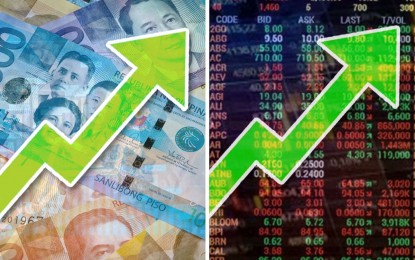
MANILA – News about the new stimulus program by the US government lifted sentiments and boosted both the Philippine peso and the main stocks gauge Tuesday.
The local currency finished the day’s trade at 50.07 against the dollar, an improvement from its 50.345 close a day ago.
It opened the day at 50.23, sideways from its 50.3 start the previous day.
It traded between 50.26 and 50.03, resulting in an average of 50.146.
Volume totaled to USD901.5 million, higher than the USD791.9 million a day ago.
Rizal Commercial Banking Corporation (RCBC) chief economist Michael Ricafort said the peso ended the day at its more than two-year high “after some improvement in global market sentiment/risk appetite” on news that the US Federal Reserve intends to purchase corporate bonds as part of its quantitative easing (QE) measures.
“Sentiment on global financial markets, including on emerging markets, such as the Philippines/peso, also supported by new stimulus plans by Trump Administration worth USD1 trillion especially infrastructure spending,” he said in a reply to an e-mail from PNA.
Ricafort said extension of the general community quarantine (GCQ) in Metro Manila and several other areas until June 30, 2020 is also a factor on the positive sentiment in the local financial market during the day.
Other contributors to the risk-on sentiment are easing of global crude oil prices, growth in domestic bank lending, and rise in domestic liquidity, he added.
Ricafort forecasts the peso to remain strong against the US dollar this year despite the fears for possible second wave of coronavirus disease (Covid-19) infections “that could lead to new lockdowns and could cause volatility in the global financial markets.”
He identified other risks including slowdown in the country’s structural decline inflows of US dollars such as overseas Filipino workers remittances, foreign tourism receipts, business process outsourcing (BPO) revenues, Philippine offshore gaming operators (POGO) revenues, foreign investments amid contraction, and risk of recession in many countries around the world due to the Covid-19 lockdowns/pandemic.
Ricafort said these factors, however, are seen to be countered by “slowdown in net imports, including oil imports that narrow the country’s trade deficit, thereby reducing the purchases of US dollars to pay for the country’s import bill.”
“The record high gross international reserves (GIR) USD90 billion levels or equivalent to 8 months of imports or double the acceptable/minimum international standard of 2-3 months, fundamentally provide greater cushion and support for the peso exchange rate,” he said.
Upgrade by the Japan Credit Rating Agency (JCRA) of its credit rating on the Philippines to A-level recently is also a plus on investors’ sentiment for the domestic financial market “as this reflects the improvement in the country’s economic and credit fundamentals in recent years, thereby could help attract more foreign investments into the country, as well as support sentiment on the peso exchange rate,” he added.
Meanwhile, the risk-on sentiment also benefited the Philippine Stock Exchange index (PSEi), which increased by 1.91 percent, or 117.93 points, to 6,281.75 points.
All Shares rose by 1.45 percent, or 52.78 points, to 3,699.61 points.
Most of the sectoral indices also gained during the day, led by the Financials counter, which posted an uptick of 3.29 percent.
Holding Firms jumped by 2.97 percent, Mining and Oil by 2.40 percent, Services by 1.41 percent, and Property by 0.57 percent.
Only the Industrial ended the day on the red after it slipped by 0.50 percent.
Volume totaled 968.67 million shares amounting to PHP6.99 billion.
Gainers led losers at 141 to 54, while 46 shares were unchanged. (PNA)
